Application of Near-infrared Spectroscopy and Multiple Spectral Algorithms to Explore the Effect of Soil Particle Sizes on Soil Nitrogen Detection
Abstract
1. Introduction
2. Results and Discussion
2.1. Analysis of Soil NIR Spectrum
2.2. Soil NIR Spectra with Different Soil Particle Sizes
2.3. Model Analysis of Spectral Data with Different Soil Particle Sizes
2.4. Spectral Analysis of Different Soil Particle Sizes
3. Materials and Methods
3.1. Experimental Materials
3.2. Experimental Materials and Sample Preparation
3.3. Soil NIR Spectra Measurement
3.4. Data Analysis
3.5. Spectral Pretreatment Methods
3.6. Spectral Modeling Methods
3.6.1. Partial Least Squares
3.6.2. Competitive Adaptive Reweighted Sampling—Partial Least Squares Method (CARS-PLS)
3.6.3. Backward Interval Partial Least Squares
3.6.4. Successive Projections Algorithm—Partial Least Squares (SPA-PLS)
3.6.5. Genetic Algorithm—Partial Least Squares (GA-PLS)
3.7. Model Evaluation Index
4. Conclusions
Supplementary Materials
Author Contributions
Funding
Conflicts of Interest
References
- Bahri, A.; Nawar, S.; Selmi, H.; Amraoui, M.; Rouissi, H.; Mouazen, A.M. Application of visible and near-infrared spectroscopy for evaluation of ewes milk with different feeds. Anim. Prod. Sci. 2019, 59, 1190. [Google Scholar] [CrossRef]
- Filippi, P.; Cattle, S.R.; Bishop, T.F.; Jones, E.J.; Minasny, B. Combining ancillary soil data with VisNIR spectra to improve predictions of organic and inorganic carbon content of soils. MethodsX 2018, 5, 551–560. [Google Scholar] [CrossRef] [PubMed]
- Paul, A.; Wander, L.; Becker, R.; Goedecke, C.; Braun, U. High-throughput NIR spectroscopic (NIRS) detection of microplastics in soil. Environ. Sci. Pollut. Res. 2018, 26, 7364–7374. [Google Scholar] [CrossRef] [PubMed]
- A Berg, I.; Porshnev, S.V.; Oshchepkova, V.Y.; Kit, M. Pulsation-based method for reduction of nitrogen oxides content in torch combustion products. J. Phys. Conf. Ser. 2018, 944, 12015. [Google Scholar] [CrossRef]
- Nie, P.; Dong, T.; He, Y.; Xiao, S.; Qu, F.; Lin, L. The Effects of Drying Temperature on Nitrogen Concentration Detection in Calcium Soil Studied by NIR Spectroscopy. Appl. Sci. 2018, 8, 269. [Google Scholar] [CrossRef]
- Nie, P.; Dong, T.; He, Y.; Xiao, S. Research on the Effects of Drying Temperature on Nitrogen Detection of Different Soil Types by Near Infrared Sensors. Sensors 2018, 18, 391. [Google Scholar] [CrossRef] [PubMed]
- Zornoza, R.; Guerrero, C.; Mataix-Solera, J.; Scow, K.; Arcenegui, V.; Mataix-Beneyto, J. Near infrared spectroscopy for determination of various physical, chemical and biochemical properties in Mediterranean soils. Soil Boil. Biochem. 2008, 40, 1923–1930. [Google Scholar] [CrossRef]
- Dalal, R.C. Simultaneous determinaton of moisture, organic carbon, and total nitrogen by near infrared reflectance spectrophotometry. Soil Sci. Soc. Am. J. 1986, 50, 120–123. [Google Scholar] [CrossRef]
- Bao, Y.-D.; He, Y.; Fang, H.; Pereira, A.G. [Spectral characterization and N content prediction of soil with different particle size and moisture content]. Guang pu xue yu guang pu fen xi = Guang pu 2007, 27, 62–65. [Google Scholar]
- Lee, K.S.; Lee, D.H.; Sudduth, K.A.; Chung, S.O.; Kitchen, N.R.; Drummond, S.T. Wavelength Identification and Diffuse Reflectance Estimation for Surface and Profile Soil Properties. Trans. ASABE 2009, 52, 683–695. [Google Scholar] [CrossRef]
- Gómez, A.H.; He, Y.; Pereira, A.G. Non-destructive measurement of acidity, soluble solids and firmness of Satsuma mandarin using Vis/NIR-spectroscopy techniques. J. Food Eng. 2006, 77, 313–319. [Google Scholar] [CrossRef]
- Cozzolino, D.; Morón, A. Potential of near-infrared reflectance spectroscopy and chemometrics to predict soil organic carbon fractions. Soil Tillage Res. 2006, 85, 78–85. [Google Scholar] [CrossRef]
- Zhu, Q.; Dong, G.M.; Yang, R.J.; Ya-Ping, Y.U.; Jiang, Q.; Yang, X.D.; Zhou, P. Influences of Soil Particle Size Difference on Detecting Total Nitrogen Contents in Soil by Spectrometry. J. Tianjin Agric. Univ. 2015, 4. (In Chinese) [Google Scholar]
- Nie, P.; Dong, T.; He, Y.; Qu, F. Detection of Soil Nitrogen Using Near Infrared Sensors Based on Soil Pretreatment and Algorithms. Sensors 2017, 17, 1102. [Google Scholar] [CrossRef] [PubMed]
- Libowitzky, E. Correlation of O-H stretching frequencies and O-H…O hydrogen bond lengths in minerals. Mon. Für Chem. 1999, 130, 1047–1059. [Google Scholar]
- Binkerd, E.F.; Harwood, H.J. The application of infrared spectroscopy to fat and oil chemistry. J. Am. Oil Chem. Soc. 1950, 27, 60–62. [Google Scholar] [CrossRef]
- Chen, S.-K.; A Edwards, C.; Subler, S. The influence of two agricultural biostimulants on nitrogen transformations, microbial activity, and plant growth in soil microcosms. Soil Boil. Biochem. 2003, 35, 9–19. [Google Scholar] [CrossRef]
- Dong, T.; Lin, L.; He, Y.; Nie, P.; Qu, F.; Xiao, S. Density Functional Theory Analysis of Deltamethrin and Its Determination in Strawberry by Surface Enhanced Raman Spectroscopy. Molecules 2018, 23, 1458. [Google Scholar] [CrossRef]
- D’Acqui, L.P.; Pucci, A.; Janik, L.J. Soil properties prediction of western Mediterranean islands with similar climatic environments by means of mid-infrared diffuse reflectance spectroscopy. Eur. J. Soil Sci. 2010, 61, 865–876. [Google Scholar] [CrossRef]
- Teye, E.; Huang, X.; Afoakwa, N. Review on the Potential Use of Near Infrared Spectroscopy (NIRS) for the Measurement of Chemical Residues in Food. Am. J. Food Sci. Technol. 2013, 1, 1–8. [Google Scholar]
- Fuwa, K.; Valle, B.L. The Physical Basis of Analytical Atomic Absorption Spectrometry. The Pertinence of the Beer-Lambert Law. Anal. Chem. 1963, 35, 942–946. [Google Scholar] [CrossRef]
- Roggo, Y.; Chalus, P.; Maurer, L.; Lema-Martinez, C.; Edmond, A.; Jent, N. A review of near infrared spectroscopy and chemometrics in pharmaceutical technologies. J. Pharm. Biomed. Anal. 2007, 44, 683–700. [Google Scholar] [CrossRef] [PubMed]
- Chu, X.L.; Yu-Peng, X.U.; Wan-Zhen, L.U. Research and Application Progress of Chemometrics Methods in Near Infrared Spectroscopic Analysis. Chin. J. Anal. Chem. 2008, 5, 031. (In Chinese) [Google Scholar]
- Geladi, P.; Kowalski, B.R. Partial least-squares regression: a tutorial. Anal. Chim. Acta 1986, 185, 1–17. [Google Scholar] [CrossRef]
- Suman, S.; Jha, R.K. A new technique for image enhancement using digital fractional-order Savitzky–Golay differentiator. Multidimens. Syst. Signal Process. 2017, 28, 709–733. [Google Scholar] [CrossRef]
- Yan, D.; Liu, S.W.; Tang, J. Feature Selection Method Based on the Adaptive Genetic Algorithm-Kernel Partial Least Squares for High Dimensional Data. Adv. Mater. Res. 2012, 468, 1762–1766. [Google Scholar] [CrossRef]
- Fearn, T.; Riccioli, C.; Garrido-Varo, A.; Guerrero-Ginel, J.E. On the geometry of SNV and MSC. Chemom. Intell. Lab. Syst. 2009, 96, 22–26. [Google Scholar] [CrossRef]
- He, Y.; Xiao, S.; Nie, P.; Dong, T.; Qu, F.; Lin, L. Research on the Optimum Water Content of Detecting Soil Nitrogen Using Near Infrared Sensor. Sensors 2017, 17, 2045. [Google Scholar] [CrossRef]
- Mccarty, G.W.; Reeves, J.B.; Reeves, V.B.; Follett, R.F.; Kimble, J.M. Mid-Infrared and Near-Infrared Diffuse Reflectance Spectroscopy for Soil Carbon Measurement. Soil Sci. Soc. Am. J. 2002, 66, 640. [Google Scholar]
- Yun, Y.-H.; Wang, W.-T.; Deng, B.-C.; Lai, G.-B.; Liu, X.-B.; Ren, D.-B.; Liang, Y.-Z.; Fan, W.; Xu, Q.-S. Using variable combination population analysis for variable selection in multivariate calibration. Anal. Chim. Acta 2015, 862, 14–23. [Google Scholar] [CrossRef]
- Krakowska, B.; Custers, D.; Deconinck, E.; Daszykowski, M. The Monte Carlo validation framework for the discriminant partial least squares model extended with variable selection methods applied to authenticity studies of Viagra® based on chromatographic impurity profiles. Analyst 2016, 141, 1060–1070. [Google Scholar] [CrossRef] [PubMed]
- Xiao, S.; He, Y.; Dong, T.; Nie, P. Spectral Analysis and Sensitive Waveband Determination Based on Nitrogen Detection of Different Soil Types Using Near Infrared Sensors. Sensors 2018, 18, 523. [Google Scholar] [CrossRef] [PubMed]
- Araújo, M.C.U.; Saldanha, T.C.B.; Galvão, R.K.H.; Yoneyama, T.; Chame, H.C.; Visani, V. The successive projections algorithm for variable selection in spectroscopic multicomponent analysis. Chemom. Intell. Lab. Syst. 2001, 57, 65–73. [Google Scholar] [CrossRef]
- Soares, S.F.C.; Galvão, R.K.H.; Araújo, M.C.U.; Da Silva, E.C.; Pereira, C.F.; De Andrade, S.I.E.; Leite, F.C. A modification of the successive projections algorithm for spectral variable selection in the presence of unknown interferents. Anal. Chim. Acta 2011, 689, 22–28. [Google Scholar] [CrossRef] [PubMed]
- Diniz, P.H.G.D.; Gomes, A.A.; Pistonesi, M.F.; Band, B.S.F.; De Araújo, M.C.U. Simultaneous Classification of Teas According to Their Varieties and Geographical Origins by Using NIR Spectroscopy and SPA-LDA. Food Anal. Methods 2014, 7, 1712–1718. [Google Scholar] [CrossRef]
- Zou, X.; Zhao, J.; Mao, H.; Shi, J.; Yin, X.; Li, Y. Genetic algorithm interval partial least squares regression combined successive projections algorithm for variable selection in near-infrared quantitative analysis of pigment in cucumber leaves. Appl. Spectrosc. 2010, 64, 786–794. [Google Scholar] [PubMed]
Sample Availability: Samples of the compounds are not available from the authors. |

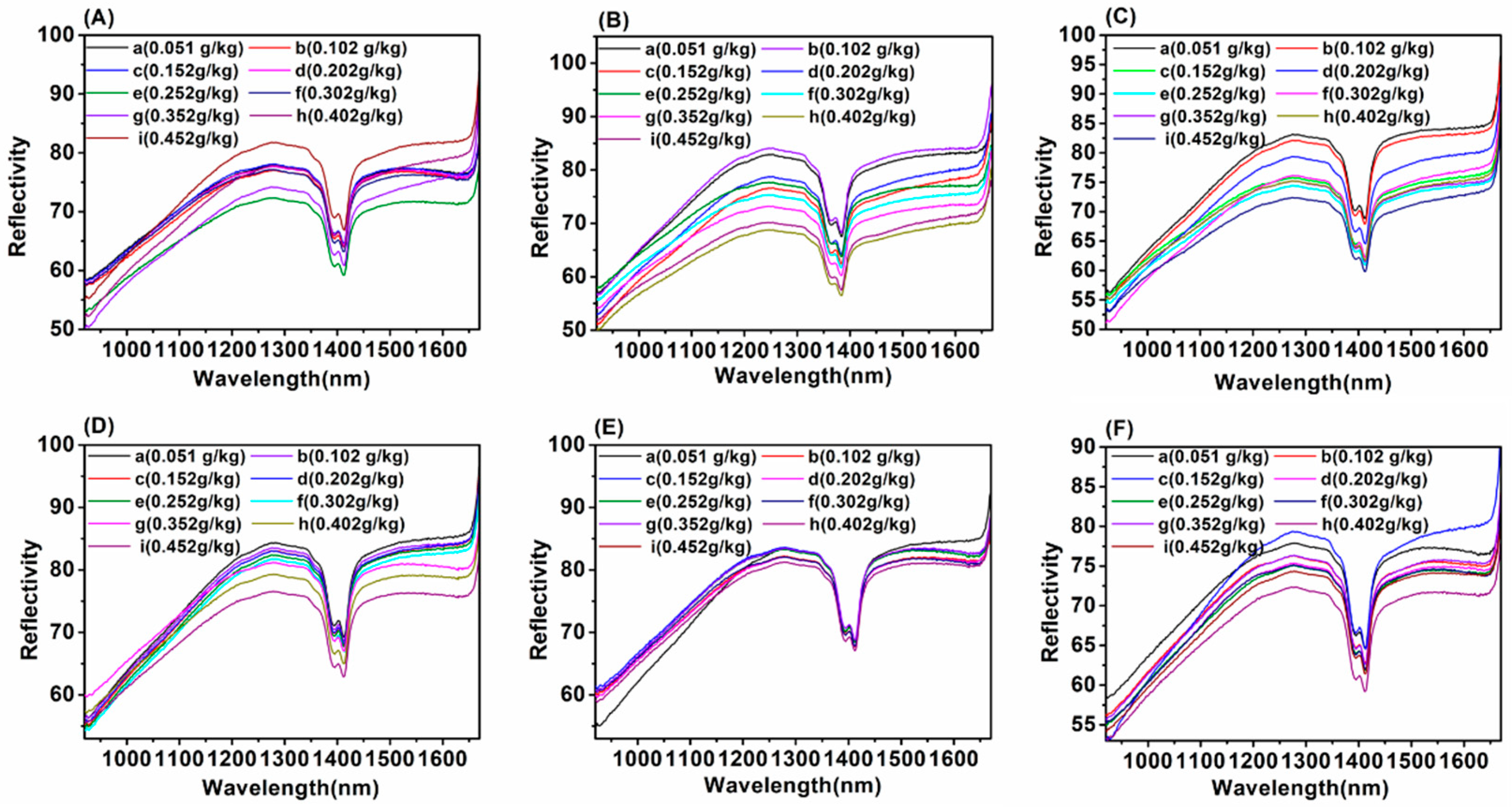

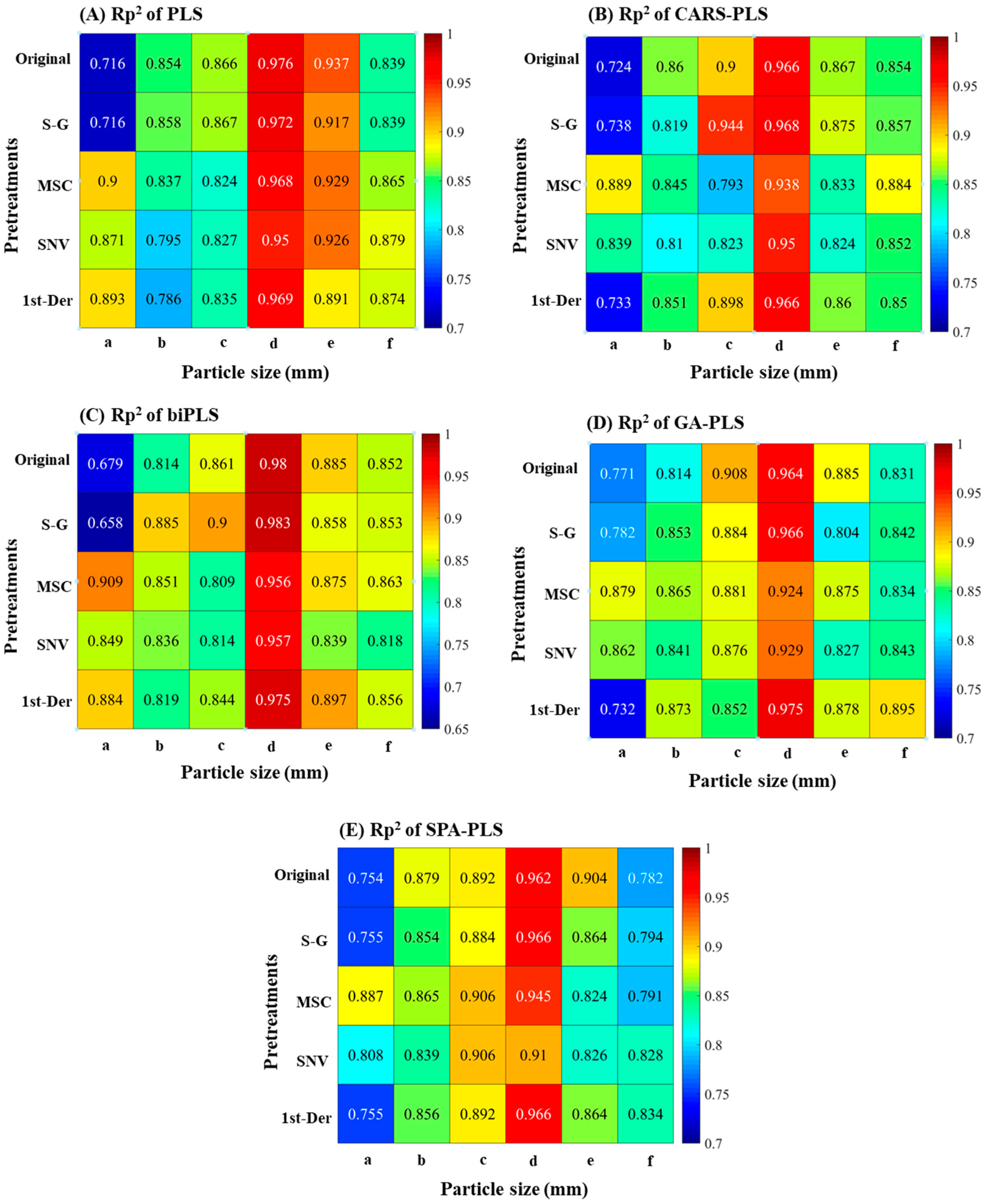
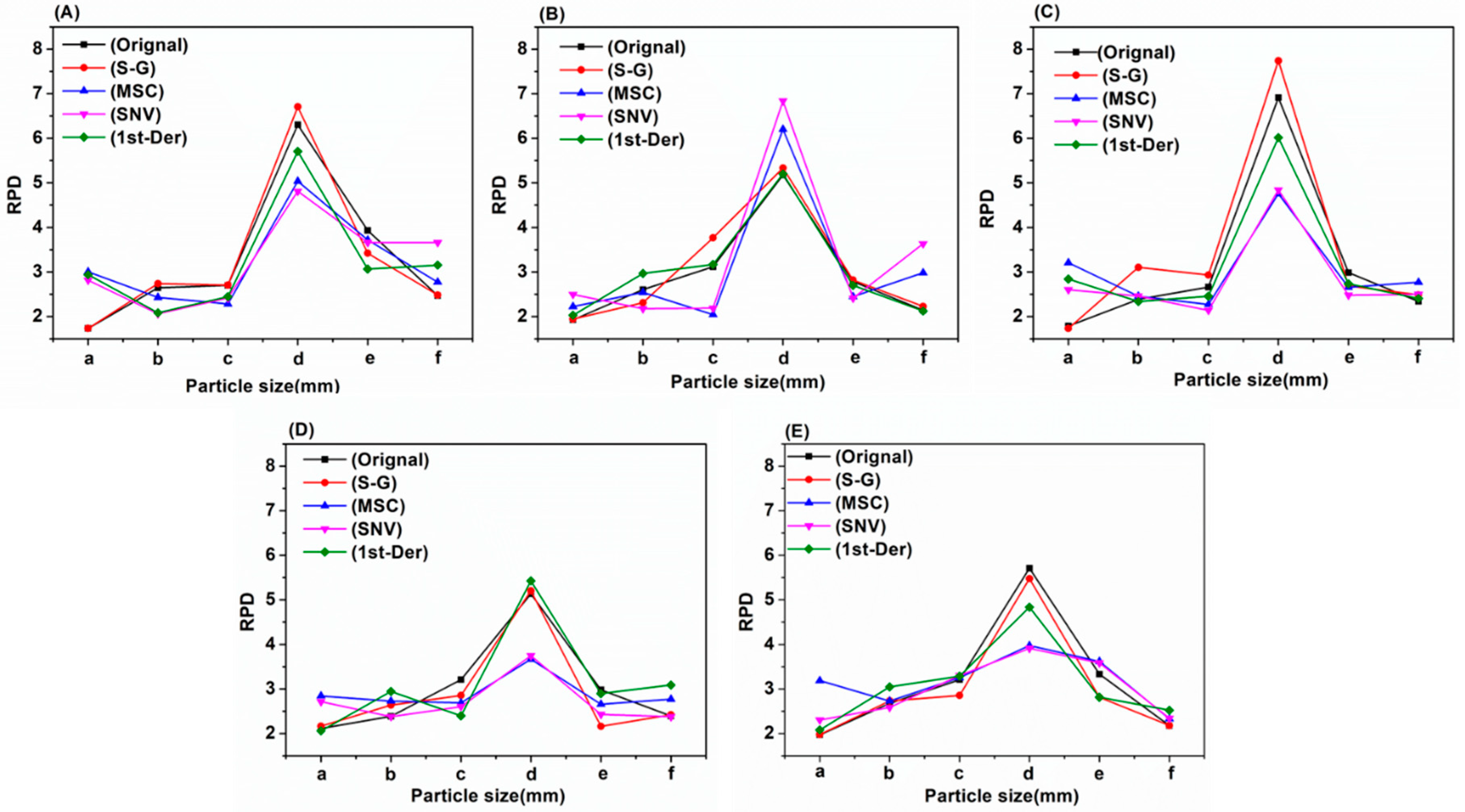
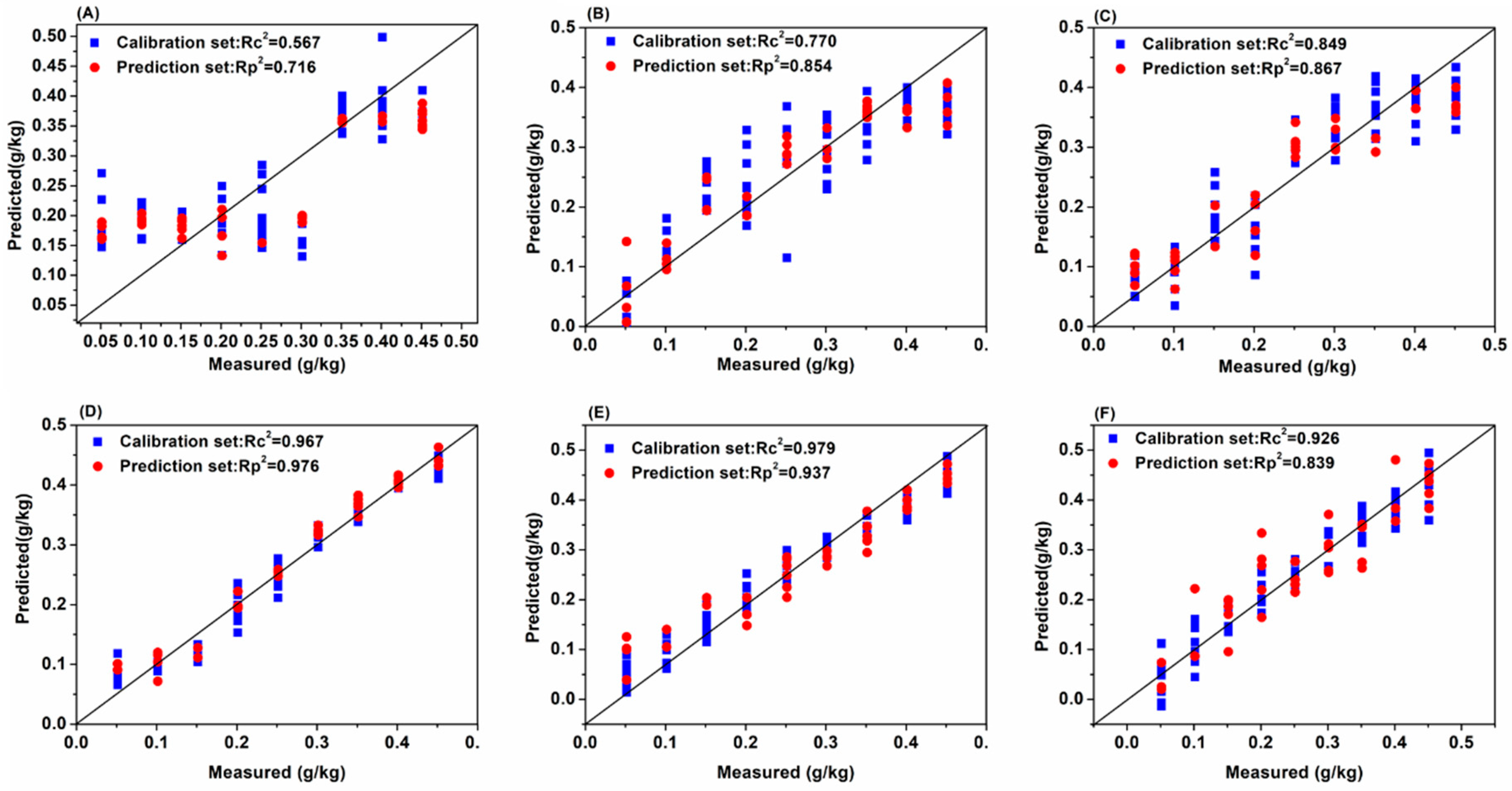
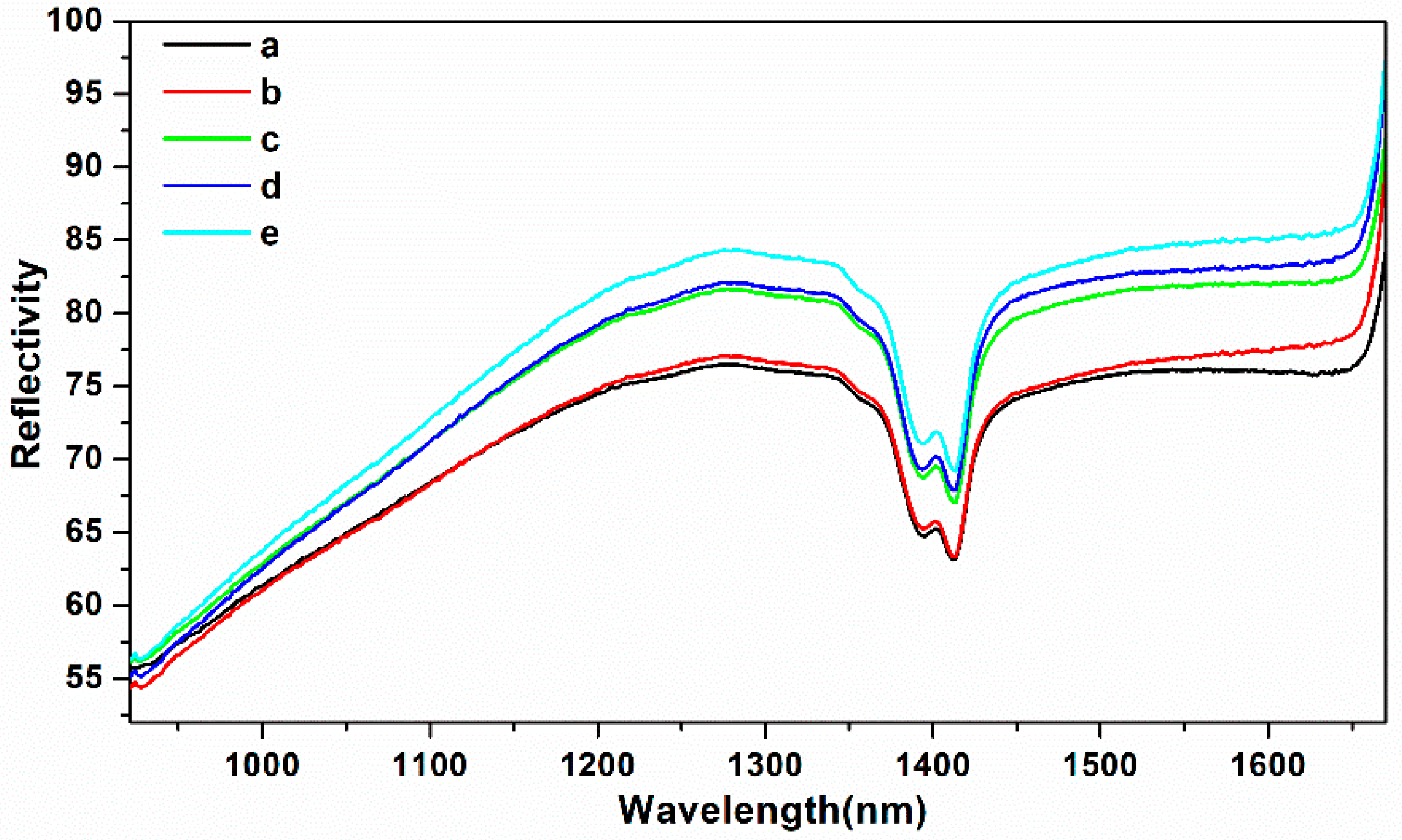
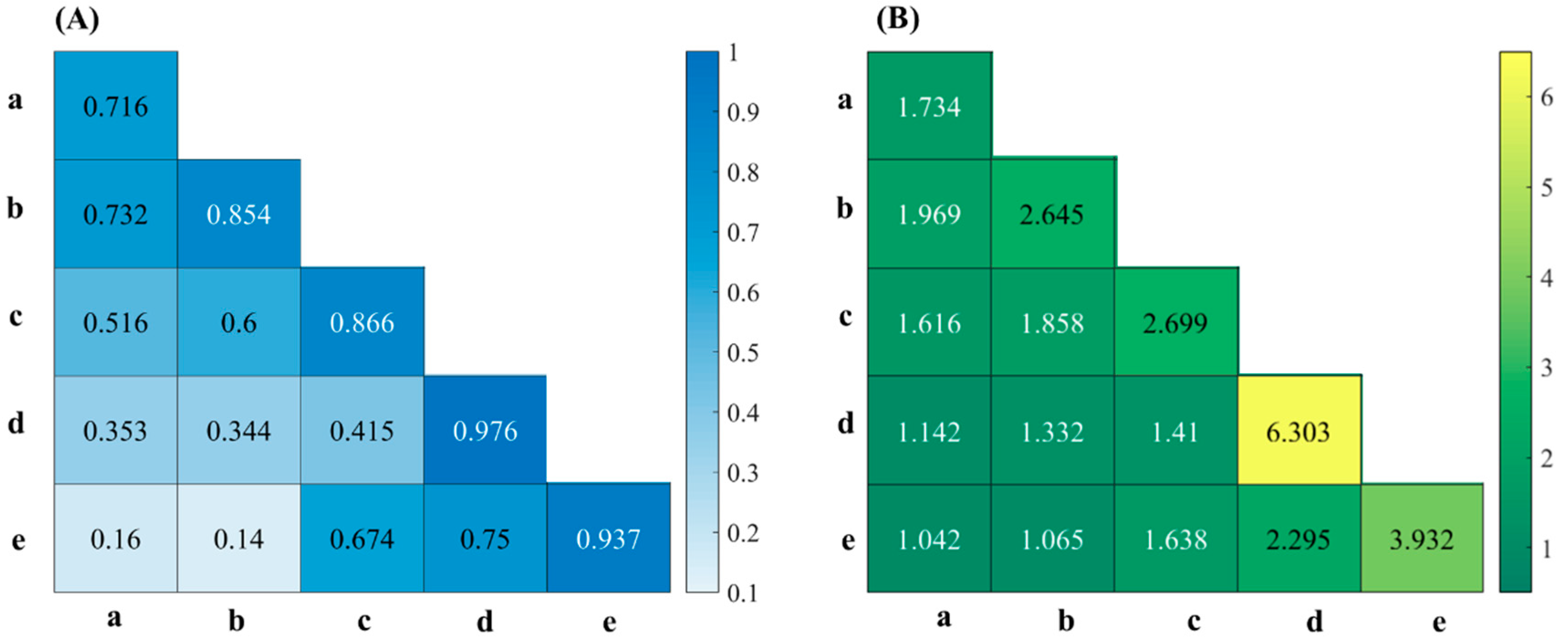
| Particle size (mm) | Pretreatments | Calibration Set | Prediction Set | |||
|---|---|---|---|---|---|---|
| Rc2 | RMSEC (g/kg) | Rp2 | RMSEP (g/kg) | RPD | ||
| 1–2 | Origin | 0.567 | 0.082 | 0.716 | 0.081 | 1.734 |
| S-G | 0.567 | 0.082 | 0.716 | 0.081 | 1.734 | |
| MSC | 0.685 | 0.065 | 0.900 | 0.048 | 3.002 | |
| SNV | 0.735 | 0.064 | 0.871 | 0.049 | 2.815 | |
| 1st-Der | 0.713 | 0.064 | 0.893 | 0.050 | 2.938 | |
| 0.45–1 | Origin | 0.770 | 0.062 | 0.854 | 0.051 | 2.645 |
| S-G | 0.772 | 0.061 | 0.858 | 0.050 | 2.739 | |
| MSC | 0.912 | 0.036 | 0.837 | 0.056 | 2.429 | |
| SNV | 0.928 | 0.033 | 0.795 | 0.065 | 2.061 | |
| 1st-Der | 0.947 | 0.029 | 0.786 | 0.068 | 2.082 | |
| 0.28–0.45 | Origin | 0.849 | 0.050 | 0.866 | 0.048 | 2.699 |
| S-G | 0.847 | 0.050 | 0.867 | 0.048 | 2.706 | |
| MSC | 0.800 | 0.059 | 0.824 | 0.042 | 2.284 | |
| SNV | 0.800 | 0.058 | 0.827 | 0.040 | 2.415 | |
| 1st-Der | 0.927 | 0.035 | 0.835 | 0.054 | 2.446 | |
| 0.18–0.28 | Origin | 0.967 | 0.023 | 0.976 | 0.020 | 6.303 |
| S-G | 0.967 | 0.023 | 0.972 | 0.019 | 6.706 | |
| MSC | 0.949 | 0.019 | 0.968 | 0.021 | 5.036 | |
| SNV | 0.969 | 0.022 | 0.950 | 0.019 | 4.811 | |
| 1st-Der | 0.970 | 0.023 | 0.969 | 0.021 | 5.706 | |
| 0–0.18 | Origin | 0.979 | 0.021 | 0.937 | 0.032 | 3.932 |
| S-G | 0.993 | 0.011 | 0.917 | 0.037 | 3.422 | |
| MSC | 0.959 | 0.026 | 0.929 | 0.036 | 3.717 | |
| SNV | 0.960 | 0.025 | 0.926 | 0.036 | 3.659 | |
| 1st-Der | 0.964 | 0.023 | 0.891 | 0.047 | 3.066 | |
| 0–2 | Origin | 0.926 | 0.026 | 0.839 | 0.051 | 2.468 |
| S-G | 0.932 | 0.034 | 0.839 | 0.051 | 2.482 | |
| MSC | 0.942 | 0.031 | 0.865 | 0.041 | 2.773 | |
| SNV | 0.940 | 0.032 | 0.879 | 0.041 | 3.659 | |
| 1st-Der | 0.927 | 0.035 | 0.874 | 0.045 | 3.154 | |
| Particle Size (mm) | Calibration Set | Prediction Set | |||
|---|---|---|---|---|---|
| Rc2 | RMSEC (g/kg) | Rp2 | RMSEP (g/kg) | RPD | |
| a + b | 0.732 | 0.064 | 0.741 | 0.072 | 1.969 |
| a + c | 0.516 | 0.088 | 0.634 | 0.083 | 1.616 |
| a + d | 0.353 | 0.011 | 0.286 | 0.113 | 1.142 |
| a + e | 0.160 | 0.118 | 0.101 | 0.121 | 1.042 |
| b + c | 0.600 | 0.081 | 0.737 | 0.072 | 1.858 |
| b + d | 0.344 | 0.105 | 0.487 | 0.098 | 1.332 |
| b + e | 0.140 | 0.118 | 0.243 | 0.124 | 1.065 |
| c + d | 0.415 | 0.099 | 0.577 | 0.092 | 1.410 |
| c + e | 0.674 | 0.075 | 0.637 | 0.077 | 1.638 |
| d + e | 0.750 | 0.064 | 0.852 | 0.056 | 2.295 |
© 2019 by the authors. Licensee MDPI, Basel, Switzerland. This article is an open access article distributed under the terms and conditions of the Creative Commons Attribution (CC BY) license (http://creativecommons.org/licenses/by/4.0/).
Share and Cite
Xiao, S.; He, Y. Application of Near-infrared Spectroscopy and Multiple Spectral Algorithms to Explore the Effect of Soil Particle Sizes on Soil Nitrogen Detection. Molecules 2019, 24, 2486. https://doi.org/10.3390/molecules24132486
Xiao S, He Y. Application of Near-infrared Spectroscopy and Multiple Spectral Algorithms to Explore the Effect of Soil Particle Sizes on Soil Nitrogen Detection. Molecules. 2019; 24(13):2486. https://doi.org/10.3390/molecules24132486
Chicago/Turabian StyleXiao, Shupei, and Yong He. 2019. "Application of Near-infrared Spectroscopy and Multiple Spectral Algorithms to Explore the Effect of Soil Particle Sizes on Soil Nitrogen Detection" Molecules 24, no. 13: 2486. https://doi.org/10.3390/molecules24132486
APA StyleXiao, S., & He, Y. (2019). Application of Near-infrared Spectroscopy and Multiple Spectral Algorithms to Explore the Effect of Soil Particle Sizes on Soil Nitrogen Detection. Molecules, 24(13), 2486. https://doi.org/10.3390/molecules24132486






